Tottenham are flying in the Premier League. Former Celtic manager Ange Postecoglou was presented with an arduous rebuilding job in the summer, and after Harry Kane’s departure to Bayern Munich, it looked even more challenging. While many believed in the Australian manager, nobody expected results this fast.
The sustainability of this early success is still up in the air, but Tottenham have looked extremely promising in this first Premier League month. Ange’s successful start has earned him the August Manager of the Month award, and the Player of the Month award has gone to his best performer – James Maddison.
Maddison’s transfer to Tottenham was nothing short of a lifesaver. The English midfielder’s ability had never been in doubt, but at Leicester, his career’s future was in serious trouble. Leicester’s instability over the years, highlighted by their journey from FA Cup winners to relegation, was perhaps the guiding factor.
Instability bred personal inconsistency, and after relegation, it was time for Maddison to find a new home. Tottenham faced similar turbulence, and going to North London was an undeniable gamble, but a few months in, both parties seem to have hit the jackpot.
In the form of a tactical analysis, this scout report explores how exactly Ange Postecoglou’s tactics are unlocking James Maddison’s full potential. From an individual perspective, this analysis considers how Maddison’s tactical role at Spurs — and consequential positioning, behaviour, and movement — are allowing him to become one of the best attacking midfielders in the world.
Structure
Before diving into Maddison’s performances, it is vital to provide some valuable context by considering the structure in which he plays. Jokingly, Ange has claimed he is “just copying Pep”. While this is obviously sarcastic, there are some undeniable tactical similarities from a macro perspective. The Positional Play, which underpins the players’ positional distribution throughout the pitch and guides the collective behaviour, leads the way. More closely, Ange uses a few other tricks Pep is associated with.
Since his time at Celtic, Postecoglou likes his fullbacks to invert, normally into the half-spaces flanking a lone defensive midfielder. This forms a 2-3 base at the heart of the structure, which is used to construct possession as well as provide a stable rest defence. The theoretical 4-2-3-1 continues to change as we move forward. Yves Bissouma tends to be the deeper midfielder flanked by the fullbacks, while the other midfielder, Pape Matar Sarr, moves higher to join James Maddison in advanced areas. Initially, they will occupy the half-spaces, with Sarr on the right and Maddison on the left.
This initial structure helps us realise where each player tends to be, both throughout the pitch but also in relation to one another. With the structure quite clear, we can now look at how it develops. The term rigid fluidity has been used to describe Tottenham’s structural behaviour, with Ange even speaking on the debate between positional fluidity and rigidity in one of his interviews.
An undeniable rigidity underpins their structure, mostly highlighted by Positional Play and other principles in possession. However, as the 58-year-old manager explained, there is a direct relationship between fluidity and the players’ understanding of his ideals in possession. As the collective understanding grows, the players naturally become more fluid in their movement.
For instance, while the 2-3 is their preferred method of construction, any of the three players know they can drop into the first line and form a temporary 3-2. Or the fullback can choose to go wide because the players will know how to reorganise themselves as a response. In other words, the manager is everywhere yet nowhere simultaneously. The players instinctively know how their possession works, so fluidity grows.
At the heart of this fluidity is James Maddison. Compared to his teammates, Maddison has a much freer role. While his position in the structure is clear, he does have the freedom to roam (to a certain degree, of course) as he sees fit. His technical ability could certainly be a significant factor behind this role, but it is his tactical ability that really makes it work. The English midfielder’s awareness, decision-making, and consequent movement and space occupation are exceptional.
Before diving deeper into Maddison’s role, the image clearly illustrates some of the ideas mentioned in this section. The structure is quite clear, and considering that this illustrates each player’s average positioning, some fluidity can also be observed. Furthermore, Maddison’s connections also provide further insight into both topics.
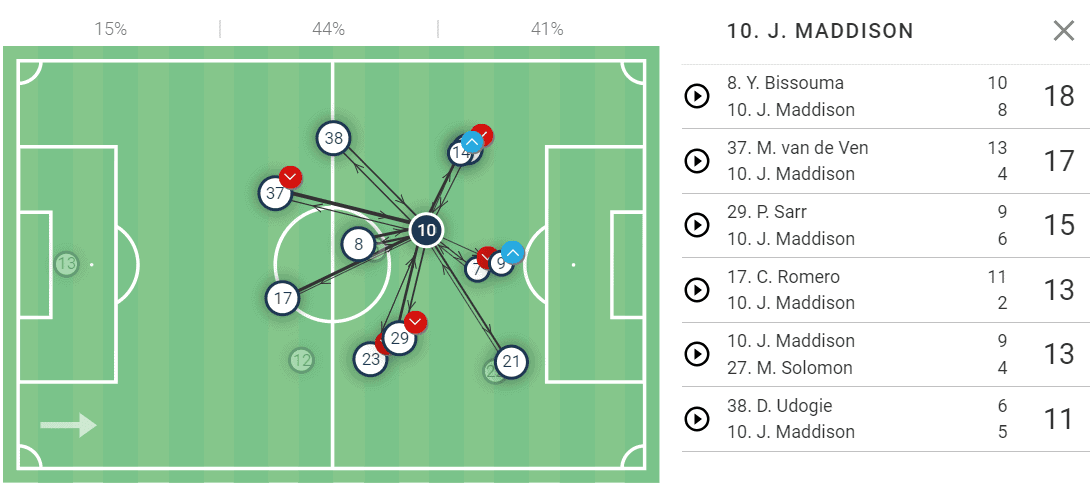
First, his highest connections are with the people closest to him, further illustrating the structure. More significantly, the volume of these connections highlights how involved Maddison is in possession, especially when the centre-backs come into the equation. In this match, Micky van de Ven and Cristian Romero found Maddison 13 and 11 times, even though Maddison is an advanced midfielder.
Searching for the game
This active involvement in possession is primarily a result of Maddison’s tendency to search for the game. Leaving his initial position, he often comes deep to get on the ball, either looking to progress or simply circulate possession.
This season, at the time of writing, Maddison averages 47.41 passes per 90, compared to 33.26 last season. Obviously, Tottenham’s collective ability to dominate possession is far greater than Leicester’s last season.
Additionally, having a more controlled and patient approach to possession will undoubtedly facilitate this growth in passing. Nonetheless, it is clear Maddison has been heavily involved in Spurs’ possession.
Moreover, Ange’s playmaker receives the ball 41.3 times per 90, compared to just 26.88 last season. This highlights the volume of his involvement, mainly due to him coming deep to get on the ball. In the instance below, against Bournemouth, Maddison has dropped into his own third to get on the ball, even getting pushed back into his own box.
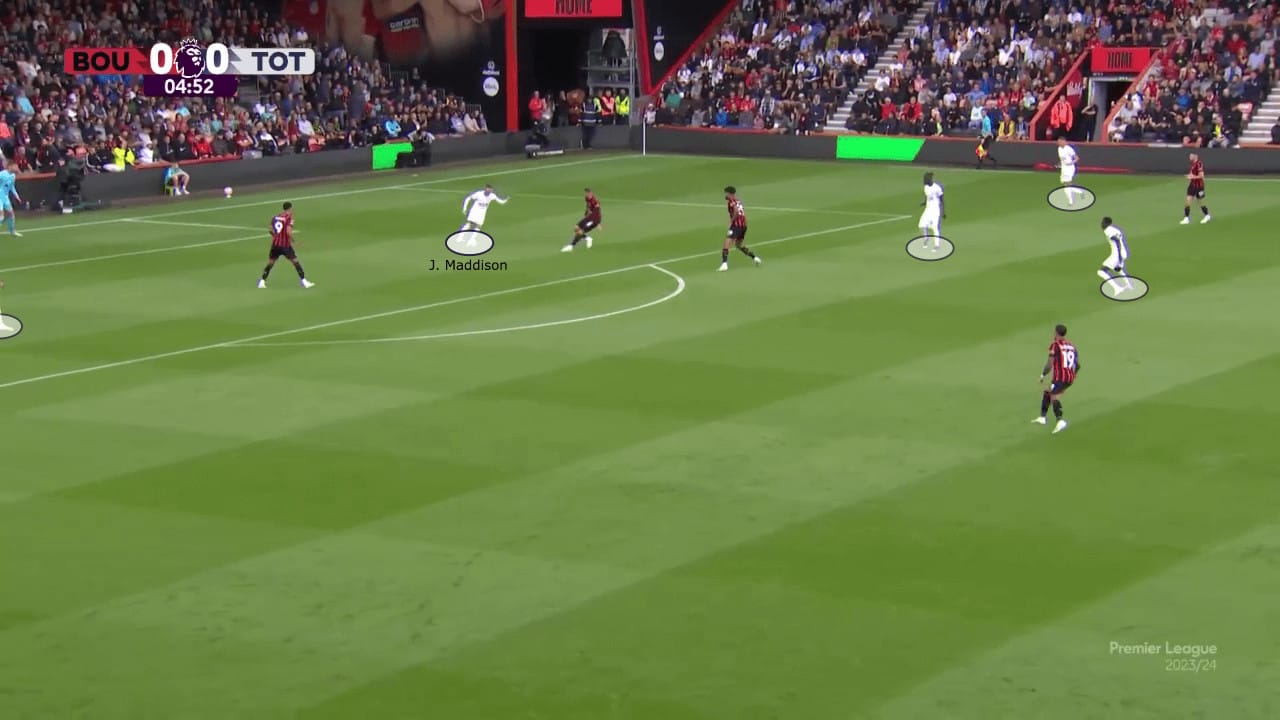
In these scenarios, his technical ability starts to shine through his ball retention. The 26-year-old has an excellent ability to simply keep possession. As Ange wants his teams to construct possession patiently and with control, this is highly valuable.
Despite the opposition’s pressure and the complex high-press systems of the Premier League, Maddison getting on the ball allows Tottenham to effectively and frequently keep the ball.
In addition to retaining possession, Maddison can also circulate possession well. He often drops deep to receive the ball from the defenders and keeps it moving. Whether this is passing back and forth with a player or moving possession from side to side, as seen below, his circulation is a potent tool in progressing to the final third.
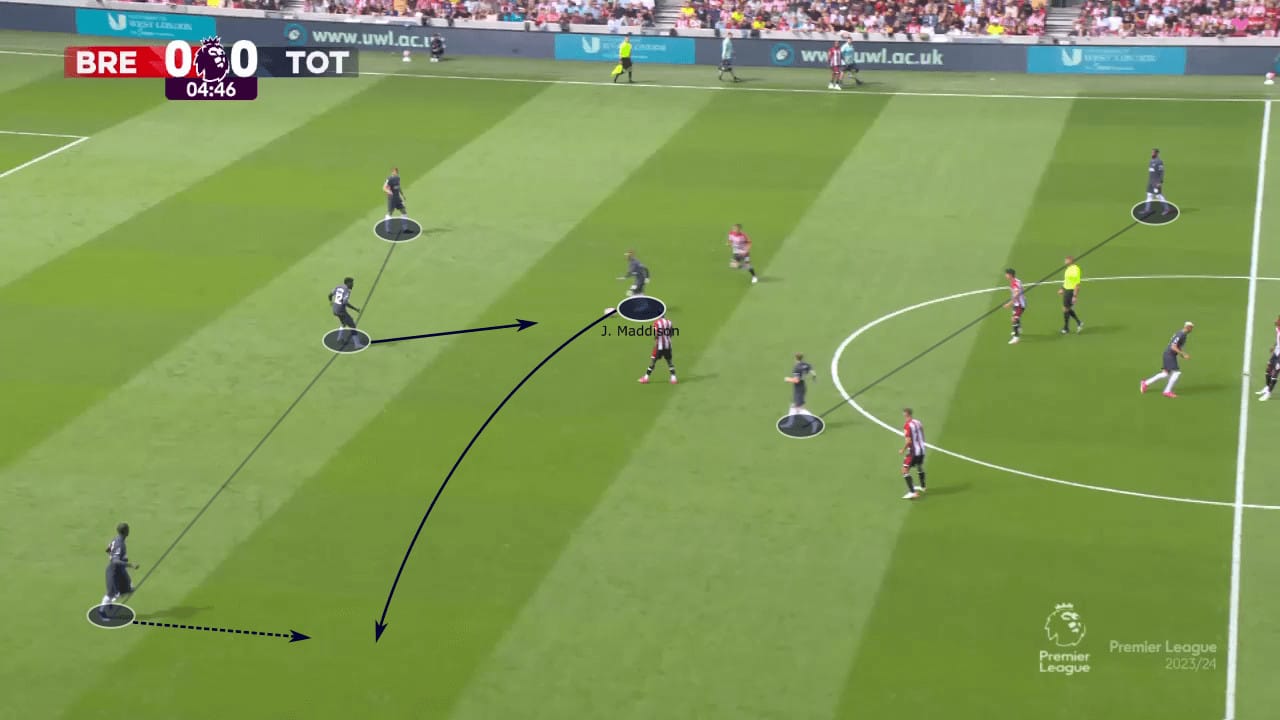
The collective fluidity previously spoken of also starts to shine once Maddison leaves his position. Coming from advanced areas, his movement will reshuffle the deck and force players to find new spaces, and this disruption can be beneficial in unlocking ways to progress forward. This reshuffling is obviously guided by a strong understanding of the possession ideals, which allows for more clarity in the decision-making.
Take the instance below, for example. As Maddison drops near the centre-backs, he leaves a gap around the left side of the pitch. Destiny Udogie, the inverted left-back, and Richarlison, the centre-forward, move into the space created by Maddison’s absence. As the play progresses on the wide channel, they can access the space and find their way into the final third.
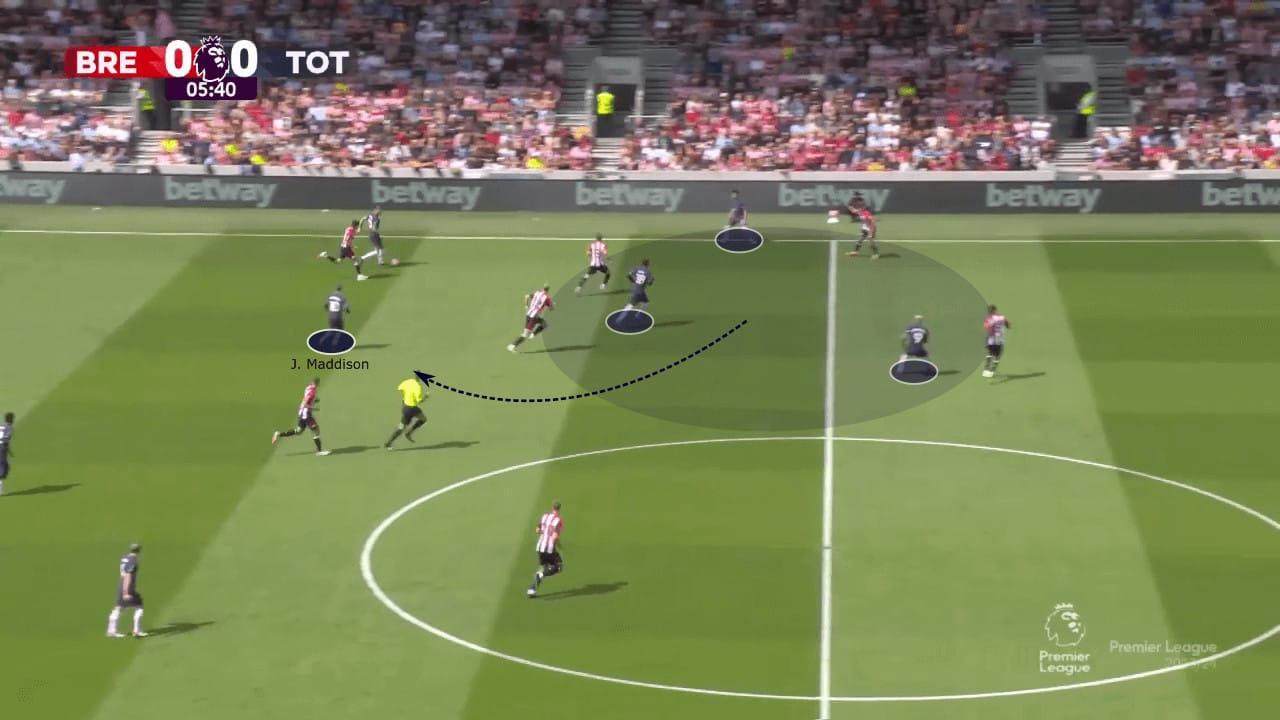
Unsurprisingly, the 26-year-old has excelled at creating with the ball at his feet. In more advanced areas, when he checks in to receive the ball, Maddison will often look to create chances or at least initiate the creation of an opportunity. In the example below, he drops deep to receive the ball from Bissouma and turns into space.
Driving at the backline, he is able to find an inch-perfect ball to Dejan Kulusevski into the final third. Maddison has averaged 6.67 passes this season into the final third with a 75% success rate.
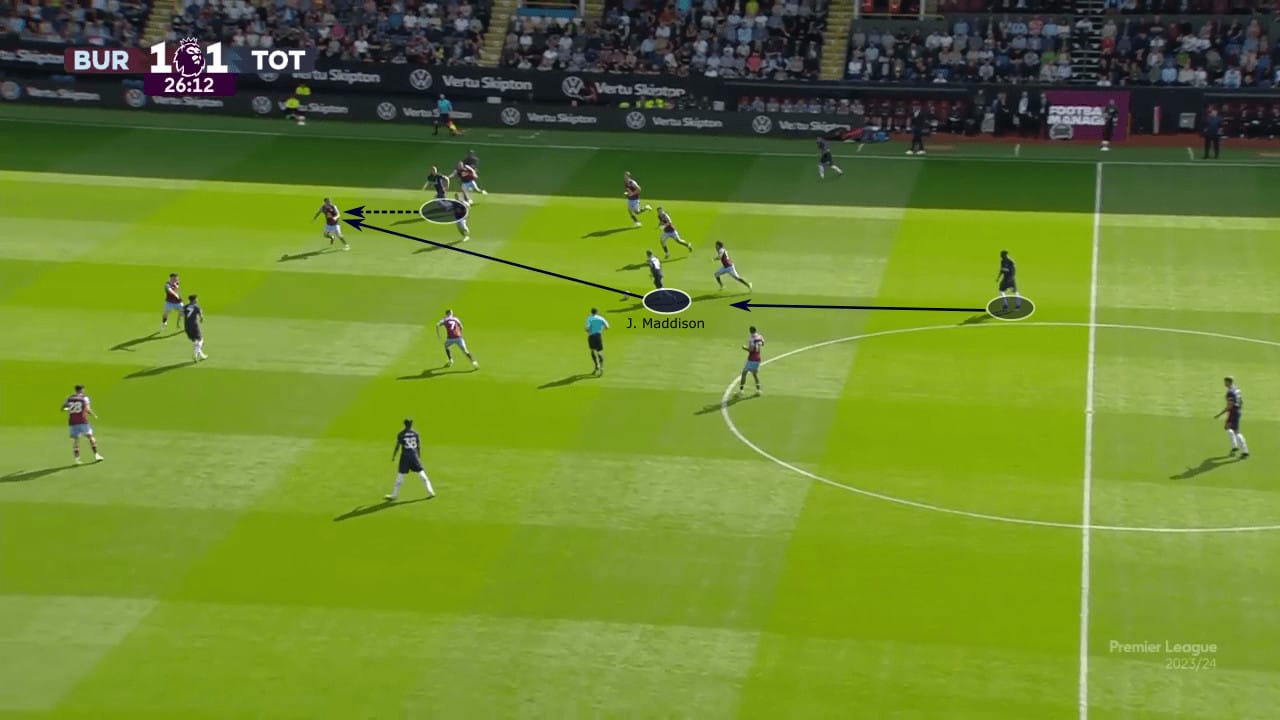
Unlocking spaces
While searching for the game has played a crucial role in fulfilling the former Leicester City player’s potential, his ability to unlock spaces has also been significant. As Tottenham look to progress possession, be it across the middle third or into the final third, Maddison is capable of discovering critical gaps and spaces inside the defensive organisation.
This is more of a process instead of a single action. He is able to spot the spaces, of course, but the timing, angle, and consequent retention and progression after receiving are all challenging to get right, and Maddison’s consistency has been great.
With football being alive and dynamic, time and space are everchanging, so different scenarios will require different solutions. Maddison’s ability to be in tune with the local information is precious. In the instance below, against Brentford, he is able to come across from the left and find a passing lane for Bissouma in between the defensive lines.
As seen in the image, he takes his first touch with his left foot, already turning to face the backline. This little detail plays a key role in providing him the extra second he needs to find Richarlison, putting the Brazilian forward in front of goal.
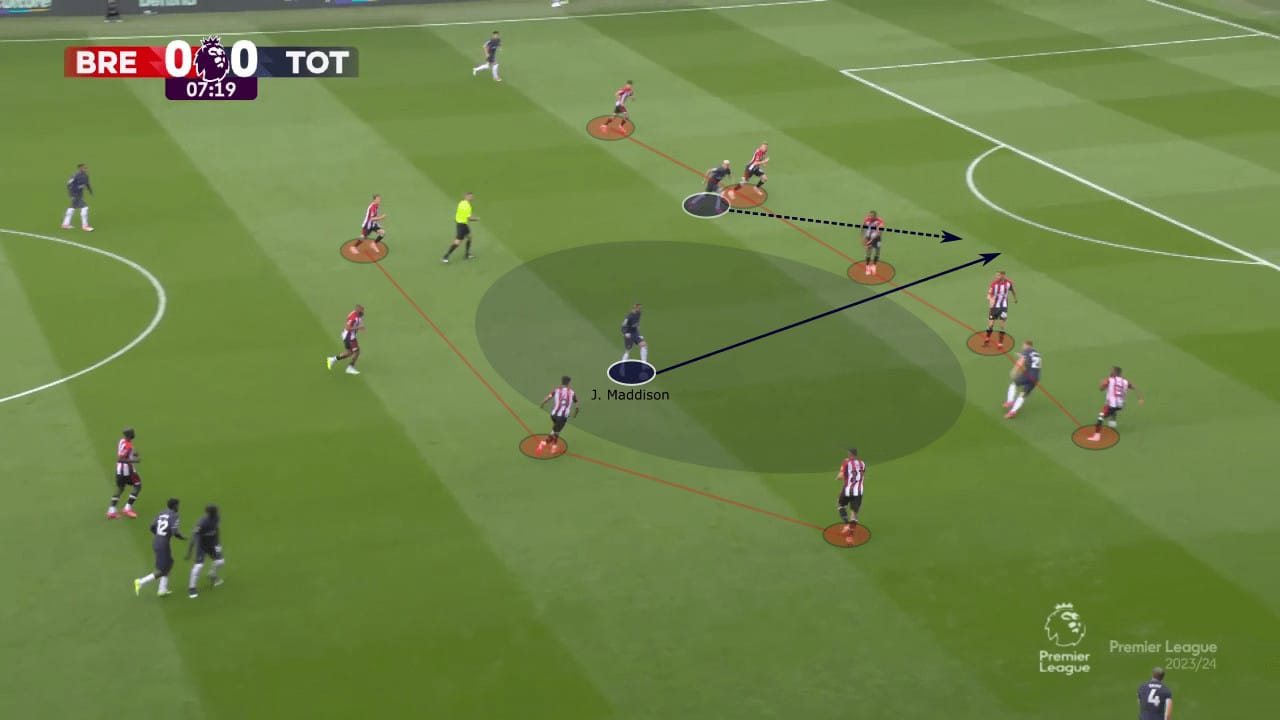
In his goal against Bournemouth, the Tottenham player’s timing is once again perfect. In the final third, as possession develops on the left-hand side, Maddison starts making his way across. As Sarr carries it outside the box, Maddison makes a run into the space behind the backline – without being offside and perfectly meeting Sarr’s pass.
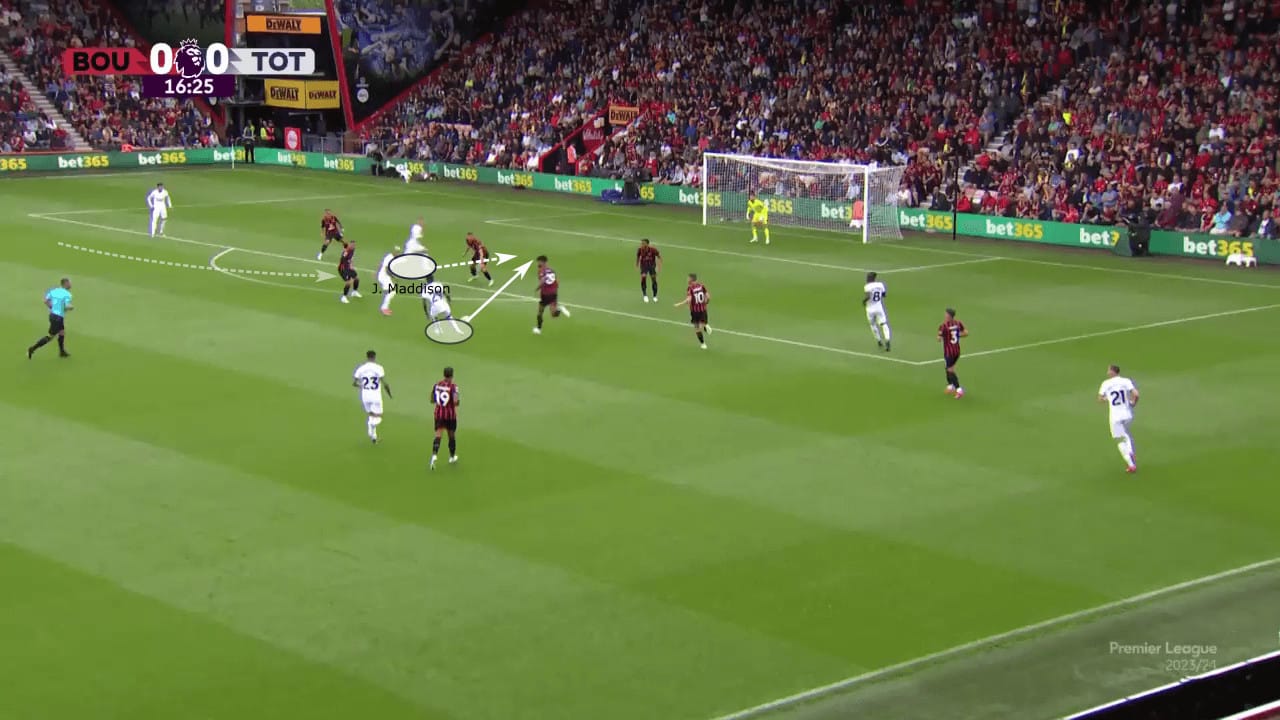
Now, in earlier phases, his realisation of future space allows Tottenham to reach the final third. After Sarr receives the ball in the middle third, Maddison, who is in line with where the ball came from, makes a run to receive the ball into space. While this may seem like a simple run, the ability to quickly spot the increase in verticality and keep up with it through an instant run forward is essential. In this case, it allows Tottenham to retain possession in the middle third, reorganise, and attack the final third.
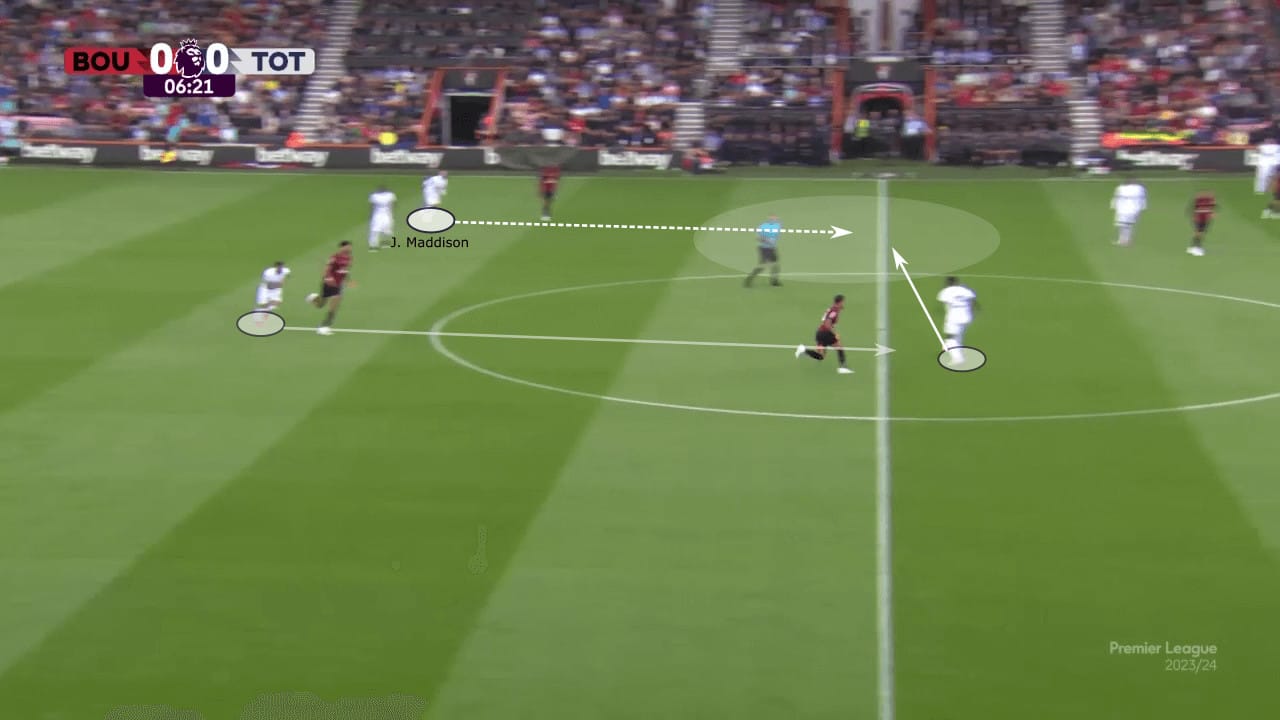
Finally, his movement in the scenario below exemplifies his tactical awareness. As Bryan Mbeumo jumps to press van de Ven, Mathias Jensen is left in a 2v1 against Maddison and Udogie. Realising this, James drops near Bissouma to get on the ball, creating a dilemma for Jensen. If he leaves him, Maddison is free to receive the ball. If he follows him, Udogie is left open. The latter happens, and after a beautiful turn by Yves, Udogie is found, and Spurs are into the final third.
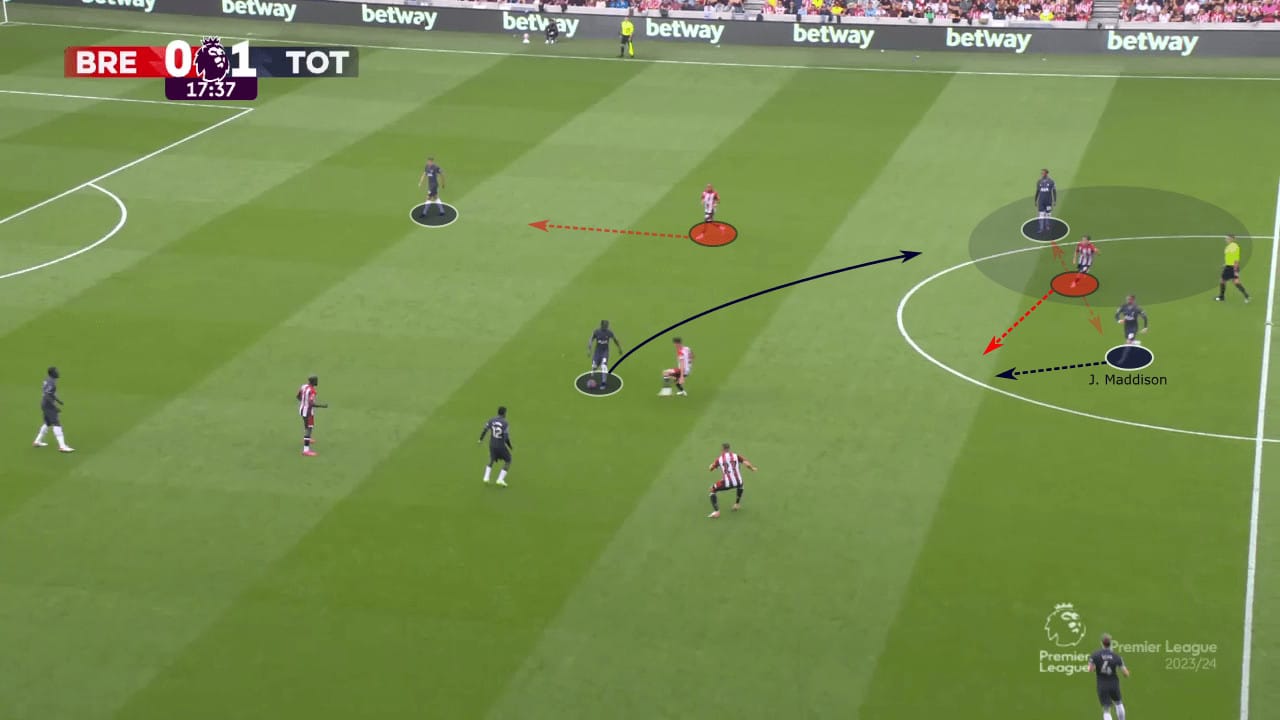
Set plays
James Maddison’s tactical role in possession has played a crucial part in Tottenham’s success as well as in realising his own potential by getting the best of his technical and mental abilities. In set plays, the 26-year-old has also given Spurs a massive boost. 11 minutes into his first Premier League game in North London, Maddison assisted Romero through a fantastic free-kick delivery. On the corner edge of the box, the English midfielder whipped an incredibly dangerous ball across the six-yard box, landing precisely on the Argentinian’s head.
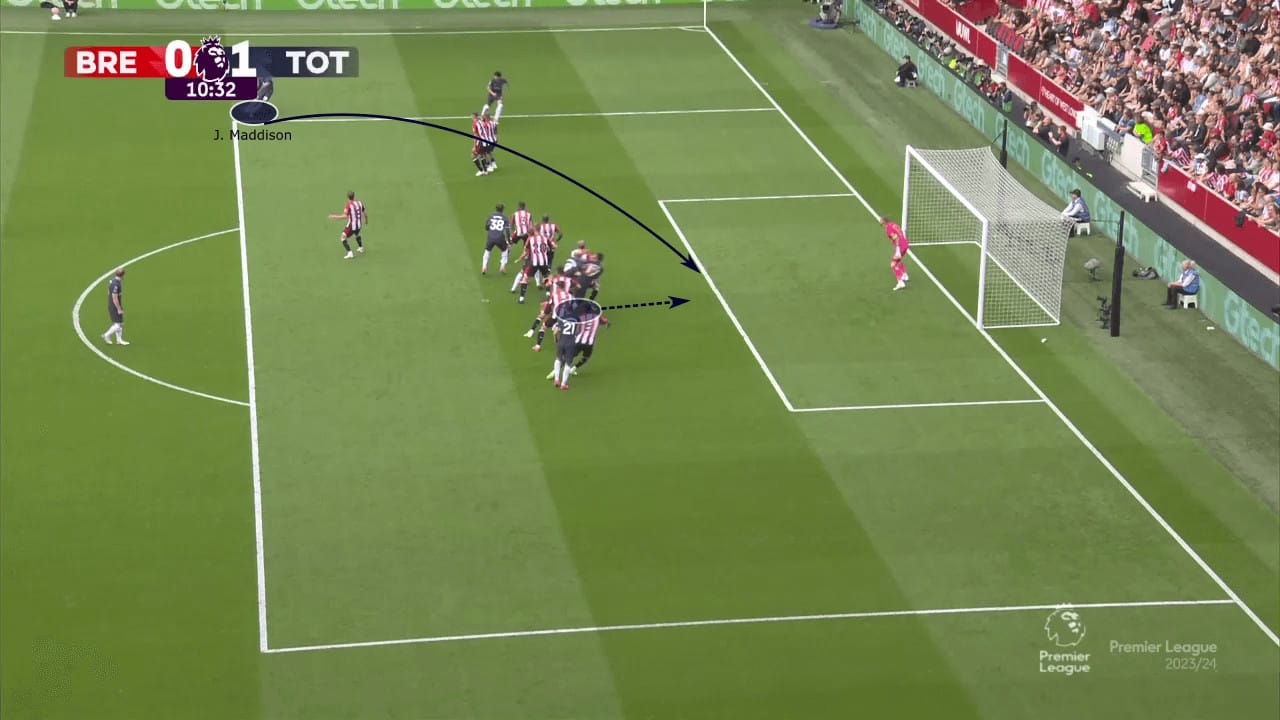
Throughout the other matches, the Englishman has delivered free-kicks with similar danger, and it would not be a surprise to see Tottenham score a few goals from opportunities like this. Against Bournemouth, for instance, in a typical “treat it like a corner” free kick, Maddison played a ball across the six-yard box with extremely dangerous pace and precision. Aiming for the far post, one of the four players in that area could have found the back of the net.
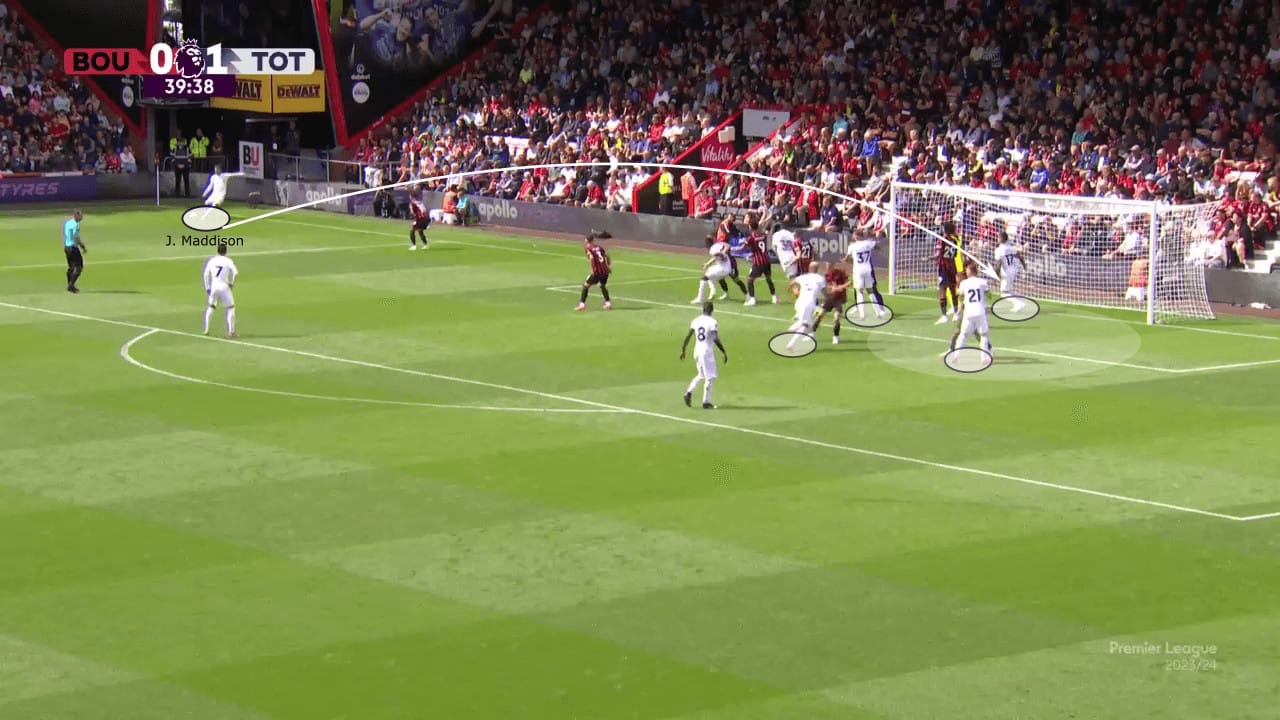
Tottenham’s deliveries have varied in corners between the front post, the middle of the six-yard box, and short combinations. Maddison takes corners on both sides, and there is a notable difference between in-swingers on the left and out-swingers on the right. Nonetheless, he has tremendously increased Tottenham’s set-play potential.
Conclusion
James Maddison has been an incredible signing for Tottenham, and under Ange Postecoglou, the 26-year-old is finally unlocking his full potential. In Ange’s tactics, Maddison has a significant and relatively free role, and so far, he has definitely proven why. The sustainability of this early success is still up in the air, but it could very well be Maddison’s season.





Comments